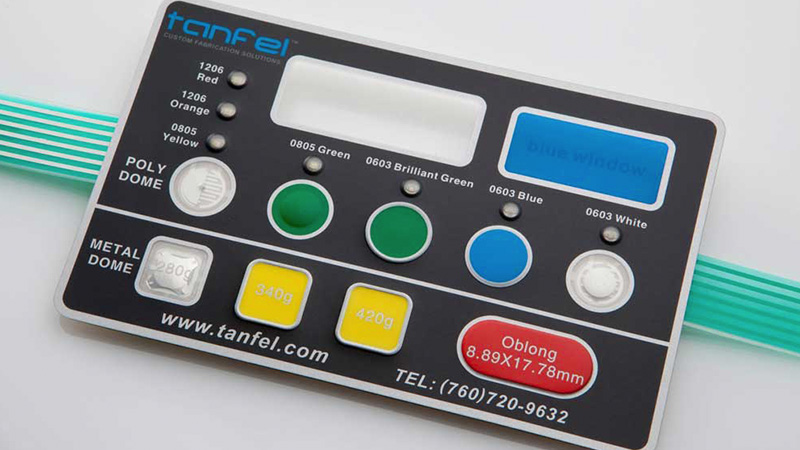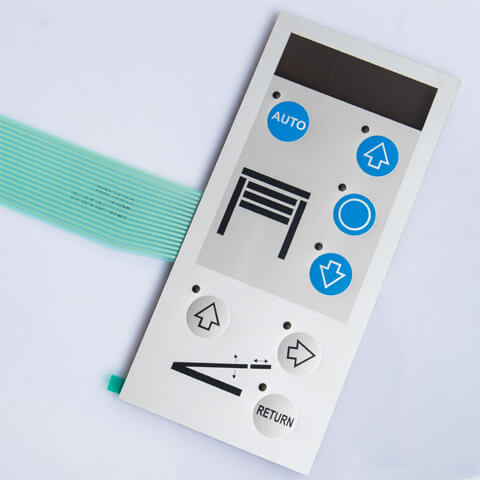Membrane Switches in the Aerospace Applications: Major Applications and Benefits
Membrane Switches in the Aerospace Applications: Major Applications and Benefits
Blog Article
Membrane Layer Change Innovation: The Key to Reliable and Economical User Interfaces
Membrane switch innovation has arised as a critical element in the layout of individual interfaces, offering both integrity and cost-effectiveness across a varied variety of applications. As we check out the multifaceted advantages of membrane switches, their potential for development increases concerns concerning future applications and advancing patterns.
Recognizing Membrane Switch Modern Technology
Membrane layer button modern technology is a commonly made use of interface service in numerous electronic devices, using a seamless mix of capability and design. This modern technology integrates numerous layers of materials, normally being composed of a visuals overlay, spacer layer, and a circuit layer. The visuals overlay shows the user interface aspects, while the spacer layer separates the circuit layer from the overlay till a customer turns on a button.
When pressure is related to the overlay, the circuit layer finishes the electrical circuit, sending out a signal to the device. This mechanism permits various arrangements, consisting of responsive comments and backlighting choices, boosting user interaction. Membrane switches are commonly produced making use of resilient materials such as polyester or polycarbonate, guaranteeing durability and resistance to ecological variables like wetness and dust.
The adaptability of membrane switches enables their application in varied sectors, including medical tools, customer electronic devices, and commercial controls. Their portable layout enables combination into space-constrained atmospheres, supplying an effective interface without endangering aesthetic charm. Comprehending the ins and outs of membrane layer button technology is essential for manufacturers and developers seeking to produce trusted and reliable human-machine interfaces.
Secret Benefits of Membrane Layer Switches
While different user interface services exist, membrane switches over offer unique advantages that make them a recommended option in various applications. Among the main advantages is their toughness; membrane switches are created to hold up against rough ecological problems, consisting of moisture, dirt, and temperature level variations, making sure long-lasting efficiency. This resilience substantially minimizes the demand for regular substitutes, therefore reducing general upkeep costs.
Additionally, membrane buttons are lightweight and compact, making them appropriate for applications where space is limited. Their low-profile design adds to a smooth look without compromising capability.
Cost-effectiveness is also a notable advantage, as the production procedure for membrane changes often tends to be less pricey contrasted to typical mechanical switches. This cost, incorporated with their reliability and ease of installment, settings membrane layer switches over as a functional solution for a large range of sectors seeking efficient and effective interface.
Applications Across Various Industries
Just how do membrane layer buttons adjust to the diverse demands of various sectors? Membrane layer button technology is progressively acknowledged for its flexibility, making it suitable for a large array of applications throughout numerous industries. In the clinical field, membrane buttons are made use of in analysis equipment and individual surveillance gadgets, where their toughness and simplicity of cleaning are crucial for maintaining hygiene criteria. The vehicle industry employs these switches in dashboards and control board, supplying a structured aesthetic while ensuring easy to use operation.
In consumer electronics, membrane switches give a portable solution for remote controls and home devices, improving user experience through user-friendly design. Additionally, the commercial field leverages membrane layer switches for equipment control board, benefiting from their resistance to extreme atmospheres, such as moisture and dirt.
Armed forces and aerospace applications likewise use membrane switches for their reliability and capacity to stand up to severe conditions, making certain operational effectiveness in critical scenarios. Moreover, the food and beverage market embraces these switches for automated systems, where sanitation and convenience of operation are critical. Inevitably, membrane layer switches are customized to meet the this special demands of each industry, proving their necessary duty in contemporary technology user interfaces
Design and Customization Options

In the world of membrane button technology, design and personalization alternatives play a crucial role in enhancing performance and individual interaction. These buttons can be customized to satisfy certain operational requirements and visual preferences, making them functional elements in different applications.
One of the key modification options is the design of the switch itself, which can be designed to fit one-of-a-kind interface and ergonomic factors to consider. By adjusting the shape, dimension, and arrangement of buttons, producers can develop user-friendly styles that facilitate ease of use. Additionally, the unification of different colors and graphic overlays permits branding and enhanced exposure, ensuring that individuals can rapidly identify functions.
Moreover, membrane buttons can be engineered with numerous tactile comments devices, such as elevated buttons or audible clicks, to enhance the user experience. Various materials can also be selected for sturdiness and ecological resistance, dealing with factors such as dampness, temperature variations, and chemical direct exposure.
Inevitably, the substantial design and customization choices readily available in membrane layer button modern technology empower businesses to produce customized services that not only satisfy useful demands however likewise straighten with their look at here branding and operational requirements.

Future Trends in Membrane Layer Buttons
As membrane layer switch technology remains to advance, future trends are increasingly focused on enhancing customer experience and integrating sophisticated capabilities. One substantial pattern is the integration of touch-sensitive and capacitive innovations right into typical membrane switches. This growth enables even more user-friendly customer interfaces, supplying responsive responses while maintaining a sleek layout.
An additional arising trend is the usage of eco-friendly materials, driven by the growing need for lasting production methods. Manufacturers are seeking to lower their carbon footprint by utilizing recyclable substrates and low-impact inks, straightening with global sustainability objectives.
Moreover, the surge of the Web of Points (IoT) is triggering the unification of clever functions into membrane buttons. Boosted connection options will certainly make it possible for devices to connect with each various other, enabling for seamless assimilation into wider systems.
In addition, improvements in printing technologies, such as additional resources digital printing, are permitting better style flexibility and modification. This enables manufacturers to produce detailed styles and dynamic shades cost-effectively.

Final Thought
In conclusion, membrane layer switch innovation represents an important technology in individual interface layout, supplying considerable advantages in sturdiness, customization, and cost-effectiveness. Its extensive applicability across varied markets underscores its significance in modern-day innovation. As innovations remain to arise, specifically in touch-sensitive user interfaces and sustainable materials, the capacity for membrane switches over to boost customer experience and performance remains appealing. Proceeded exploration of this innovation will likely generate better renovations and widen its range in future applications.
Report this page